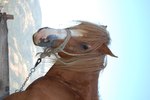There's a reason tetanus is colloquially known as lockjaw: One of the final symptoms, is the inability to open the mouth. If you catch the symptoms early, it may be possible to save your goat through aggressive treatment -- but most stricken caprines die. Fortunately, it's easy to avoid tetanus by keeping your goats' vaccinations up to date and thoroughly cleaning and disinfecting any wounds.
Tetanus Causes
Tetanus results from Clostridium tetani infection. While the bacteria can enter any open wound on the body, puncture wounds are especially troublesome -- because puncture wounds shield these anaerobic bacteria from oxygen, which kills them off.
Early Symptoms
Initial symptoms of tetanus include a stiffening of the tail and ears, along with a general body stiffness. An affected goat may stand in a rigid-legged "sawhorse" stance. If your goat displays these symptoms and isn't current on his vaccinations, call your veterinarian immediately.
Progressive Symptoms
Symptoms of tetanus rapidly worsen. After the early stiffness, more serious signs of the disease include:
- Inability to move, drink or eat
- High pulse rate
- Complete leg rigidity
- Collapsing if touched or when hearing a loud noise
- Seizures
Once a goat develops these symptoms, he's likely to die within 36 hours. He actually succumbs to asphyxiation because his respiratory system is paralyzed.
Tetanus Treatment
There's always a slim chance that a goat with tetanus can pull through with medication and supportive care. No matter whether the goat lives or dies, treatment is expensive and time-consuming. Your vet will administer high doses of antibiotics, tetanus anti-toxin and anti-inflammatories for pain relief. Your vet should find the likely source of the bacterial invasion, open it to the air if necessary, and treat the wound directly with antibiotics.
Tips
Since tetanus virtually always occurs after a goat receives a wound or undergoes some sort of bodily invasion -- such as disbudding of horns in kids -- keep tetanus antitoxin on hand if you don't know the animal's vaccination status or if vaccinations aren't current.
References
Writer Bio
Jane Meggitt has been a writer for more than 20 years. In addition to reporting for a major newspaper chain, she has been published in "Horse News," "Suburban Classic," "Hoof Beats," "Equine Journal" and other publications. She has a Bachelor of Arts in English from New York University and an Associate of Arts from the American Academy of Dramatics Arts, New York City.




